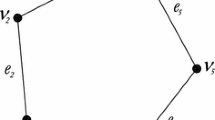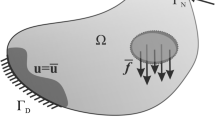Abstract
The present paper is the second part of a twofold work, whose first part is reported in Artioli et al. (Comput Mech, 2017. doi:10.1007/s00466-017-1404-5), concerning a newly developed Virtual element method (VEM) for 2D continuum problems. The first part of the work proposed a study for linear elastic problem. The aim of this part is to explore the features of the VEM formulation when material nonlinearity is considered, showing that the accuracy and easiness of implementation discovered in the analysis inherent to the first part of the work are still retained. Three different nonlinear constitutive laws are considered in the VEM formulation. In particular, the generalized viscoelastic model, the classical Mises plasticity with isotropic/kinematic hardening and a shape memory alloy constitutive law are implemented. The versatility with respect to all the considered nonlinear material constitutive laws is demonstrated through several numerical examples, also remarking that the proposed 2D VEM formulation can be straightforwardly implemented as in a standard nonlinear structural finite element method framework.








Similar content being viewed by others
Notes
In the following, the space of symmetric traceless second-order tensors is denoted by \({{\mathrm{\mathrm {SymDev}}}}\).
Note that, in the case \(k=1\), a single Gauss point for the whole polygon (for instance at the centroid of the element) is sufficient, see [45].
References
Ahmad B, Alsaedi A, Brezzi F, Marini LD, Russo A (2013) Equivalent projectors for virtual element methods. Comput Math Appl 66(3):376–391
Andersen O, Nilsen H, Raynaud X. On the use of the virtual element method for geomechanics on reservoir grids. Preprint arXiv:1606.09508
Artioli E, Beirão da Veiga L, Lovadina C, Sacco E (2017) Arbitrary order 2D virtual elements for polygonal meshes: part I, elastic problem. Comput Mech. doi:10.1007/s00466-017-1404-5
Artioli E, Bisegna P (2014) Dissipation-based approach and robust integration algorithm for 3D phenomenological constitutive models for shape memory alloys. In: Huerta A, Oñate EE, Oliver X (eds.) 11th World congress on computational mechanics, WCCM 2014, 5th european conference on computational mechanics, ECCM 2014 and 6th european conference on computational fluid dynamics, ECFD 2014, pp 4263–4272 (2014). http://www.scopus.com/inward/record.url?eid=2-2.0-84923974563&partnerID=40&md5=ae03fbc32209dcd21e59d82d3dae4ea3
Artioli E, Bisegna P (2016) An incremental energy minimization state update algorithm for 3D phenomenological internal-variable SMA constitutive models based on isotropic flow potentials. Int J Numer Methods Eng 105(3):197–220. doi:10.1002/nme.4967
Artioli E, Marfia S, Sacco E, Taylor R (2012) A nonlinear plate finite element formulation for shape memory alloy applications. Int J Numer Methods Eng 89(10):1249–1271. doi:10.1002/nme.3285
Auricchio F, Petrini L (2002) Improvements and algorithmical considerations on a recent three-dimensional model describing stress-induced solid phase transformations. Int J Numer Methods Eng 55:1255–1284
Auricchio F, Taylor R (1999) A return-map algorithm for general associative isotropic elasto-plastic materials in large deformation regimes. Int J Plast 15:1359–1378
Beirão da Veiga L, Brezzi F, Cangiani A, Manzini G, Marini LD, Russo A (2013) Basic principles of virtual element methods. Math Models Methods Appl Sci 23(1):199–214
Beirão da Veiga L, Brezzi F, Marini LD (2013) Virtual elements for linear elasticity problems. SIAM J Numer Anal 51(2):794–812
Beirão da Veiga L, Brezzi F, Marini LD, Russo A (2014) The hitchhiker’s guide to the virtual element method. Math Models Methods Appl Sci 24(8):1541–1573
Beirão da Veiga L, Brezzi F, Marini LD, Russo A (2016) Virtual element methods for general second order elliptic problems on polygonal meshes. Math Models Methods Appl Sci 26(4):729–750
Benedetto MF, Berrone S, Borio A, Pieraccini S, Scialò S (2016) A hybrid mortar virtual element method for discrete fracture network simulations. J Comput Phys 306:148–166
Benedetto MF, Berrone S, Pieraccini S, Scialò S (2014) The virtual element method for discrete fracture network simulations. Comput Methods Appl Mech Eng 280:135–156
Brezzi F, Falk RS, Marini LD (2014) Basic principles of mixed virtual element methods. ESAIM Math Model Numer Anal 48(4):1227–1240
Brezzi F, Marini LD (2013) Virtual element methods for plate bending problems. Comput Methods Appl Mech Eng 253:455–462
Caceres E, Gatica G (2016) A mixed virtual element method for the pseudostress–velocity formulation of the Stokes problem. IMA J. of Numer. Anal. doi:10.1093/imanum/drw002 (To appear on)
Cangiani A, Georgoulis E, Houston P (2014) hp-version discontinuous Galerkin methods on polygonal and polyhedral meshes. Math Models Methods Appl Sci 24(10):2009–2041
Di Pietro D, Alexandre Ern A (2015) A hybrid high-order locking-free method for linear elasticity on general meshes. Comput Methods Appl Mech Eng 283:1–21
Droniou J, Eymard R, Gallouët T, Herbin R (2013) Gradient schemes: a generic framework for the discretisation of linear, nonlinear and nonlocal elliptic and parabolic equations. Math Models Methods Appl Sci 23(13):2395–2432
Evangelista V, Marfia S, Sacco E (2009) Phenomenological 3D and 1D consistent models for shape-memory alloy materials. Comput Mech 44(3):405–421. doi:10.1007/s00466-009-0381-8
Evangelista V, Marfia S, Sacco E (2010) A 3D SMA constitutive model in the framework of finite strain. Int J Numer Methods Eng 86(6):761–785. doi:10.1002/nme
Gain AL, Paulino GH, Leonardo SD, Menezes IFM (2015) Topology optimization using polytopes. Comput Methods Appl Mech Eng 293:411–430
Gain AL, Talischi C, Paulino GH (2014) On the virtual element method for three-dimensional linear elasticity problems on arbitrary polyhedral meshes. Comput Methods Appl Mech Eng 282:132–160
Hackl K, Fischer F (2008) On the relation between the principle of maximum dissipation and inelastic evolution given by dissipation potentials. Proc Soc Ser A 464:117–132
Han W, Reddy BD (1999) Plasticity: mathematical theory and numerical analysis. Springer, New York
Jírasek M, Bazant ZP (2001) Inelastic analysis of structures. Wiley, Hoboken
Lubliner J (1990) Plasticity theory. Macmillan, London
Mielke A, Roubícek T (2015) Rate independent systems—theory and applications. Springer, New York
Mora D, Rivera G, Rodríguez R (2015) A virtual element method for the Steklov eigenvalue problem. Math Models Methods Appl Sci 25(8):1421–1445
Mousavi SE, Sukumar N (2011) Numerical integration of polynomials and discontinuous functions on irregular convex polygons and polyhedrons. Comput Mech 47(5):535–554
Mousavi SE, Sukumar N (2011) Numerical integration of polynomials and discontinuous functions on irregular convex polygons and polyhedrons. Comput Mech 47(5):535–554. doi:10.1007/s00466-010-0562-5
Mousavi SE, Xiao H, Sukumar N (2010) Generalized gaussian quadrature rules on arbitrary polygons. Int J Numer Methods Eng 82(1):99–113. doi:10.1002/nme.2759
Orgéas L, Favier D (1995) Non-symmetric tension-compression behavior of NiTi alloy. J Phys IV C8:605–610
Perugia I, Pietra P, Russo A. A plane wave virtual element method for the Helmholtz problem. ESAIM Math Mod Numer Anal (To appear on)
Rand A, Gillette A, Bajaj C (2013) Interpolation error estimates for mean value coordinates over convex polygons. Adv Comput Math 39(2):327–347
Simo JC, Hughes TJR (1998) Computational inelasticity. Springer, New York
Sommariva A, Vianello M (2007) Product gauss cubature over polygons based on green’s integration formula. BIT Numer Math 47(2):441–453. doi:10.1007/s10543-007-0131-2
Souza A, Mamiya E, Zouain N (1998) Three-dimensional model for solids undergoing stress-induced phase transformations. Eur J Mech A Solids 17:789–806
de Souza Neto, EA, Peric D, Owen DRJ (2008) Computational methods for plasticity: theory and applications. Wiley, Chichester
Sukumar N, Tabarraei A (2004) Conforming polygonal finite elements. Int J Numer Methods Eng 61(12):2045–2066
Talischi C, Paulino GH (2014) Addressing integration error for polygonal finite elements through polynomial projections: a patch test connection. Math Models Methods Appl Sci 24(8):1701–1727
Talischi C, Paulino GH, Pereira A, Menezes IFM (2012) PolyMesher: a general-purpose mesh generator for polygonal elements written in Matlab. Struct Multidiscip Optim 45(3):309–328
Vacca G (2016) Virtual element methods for hyperbolic problems on polygonal meshes. Comp Math Appl (2016) (To appear on)
Beirão da Veiga L, Lovadina C, Mora D (2015) A virtual element method for elastic and inelastic problems on polytope meshes. Comput Methods Appl Mech Eng 295:327–346
Wriggers P, Rust W, Reddy B. A virtual element method for contact. Submitted for publication
Zienkiewicz OC, Taylor RL, Fox DD (2014) The finite element method for solid and structural mechanics. Butterworth Heinemann, Oxford
Zienkiewicz OC, Taylor RL, Zhu JZ (2013) The finite element method: its basis and fundamentals. Butterworth Heinemann, Oxford
Acknowledgements
The first author gratefully acknowledges the partial financial support of the Italian Minister of University and Research, MIUR (Program: Consolidate the Foundations 2015; Project: BIOART; Grant no. (CUP): E82F16000850005). The second and third authors were partially supported by IMATI-CNR of Pavia, Italy. This support is gratefully acknowledged
Author information
Authors and Affiliations
Corresponding author
Rights and permissions
About this article
Cite this article
Artioli, E., Beirão da Veiga, L., Lovadina, C. et al. Arbitrary order 2D virtual elements for polygonal meshes: part II, inelastic problem. Comput Mech 60, 643–657 (2017). https://doi.org/10.1007/s00466-017-1429-9
Received:
Accepted:
Published:
Issue Date:
DOI: https://doi.org/10.1007/s00466-017-1429-9




